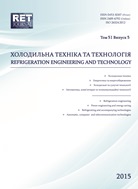ТЕРМОДИНАМІЧНІ ЦИКЛИ ТА ПРАВИЛА РЕГУЛЮВАННЯ СИСТЕМ ОБОРОТНОГО ВОДОПОСТАЧАННЯ З ВИПАРНИМИ ОХОЛОДЖУВАЧАМИ
DOI:
https://doi.org/10.15673/0453-8307.6/2015.44775Parole chiave:
правила регулювання систем оборотного водопостачання, вентиляторні і баштові градирні, термодинамічний цикл, термодинамічний ККДAbstract
Проведено аналіз існуючої нормативної документації з проектування баштових і вентиляторних градирень. Показано, що ця документація застаріла і потребує вдосконалення. Такі критерії ефективності охолоджувачів систем оборотного водопостачання (СОВ) як коефіцієнт масообміну, фактор ефективності зрошувача і графіки охолодження втратили своє практичне значення і не можуть виконувати поставлене завдання. Для аналізу роботи СОВ з різними охолоджувачами введені термодинамічні цикли, що будуються в координатах Температура-Час. В якості інтегрального показника їхньої ефективності пропонується використовувати термодинамічний ККД СОВ, який визначається як відношення зміни температури охолоджуваної в охолоджувачі води до її кінцевої температурі. Наведено схематичні термодинамічні цикли СОВ з градирнею, бризкальним басейном і ставком-охолоджувачем та проведено всебічний аналіз специфічних особливостей їх експлуатації. Сформульовано три правила регулювання СОВ: 1) при введенні і виведенні потужностей теплообмінного обладнання необхідно зберігати рівність результуючої різниці температур в охолоджувачах і нагрівачах циркуляційної води; 2) зміна гідравлічного навантаження на охолоджувач без зниження його ефективності допускається тільки в межах робочої зони його індивідуальної характеристики; 3) падіння термодинамічного ККД СОВ в проектних виробничих і погодних умовах свідчить про необхідність проведення належного техобслуговування або ремонту відповідного обладнання. На основі запропонованих термодинамічних циклів та їх аналізу проведено порівняльну оцінку градирень, бризкальних басейнів і ставків-охолоджувачів. Вказано основні несправності випарних охолоджувачів, що впливають на оцінку ефективності роботи СОВ і потребують їх своєчасного усунення.Riferimenti bibliografici
Sosnovskiy S.K., Kravchenko V.P. koeffitsient effektivnosti rabotyi ventilyatornyih i bashennyih gradiren //Teploenergetika. 2014. # 9. S. 20-25. 2. SNiP 2.04.02-84. Vodosnabzhenie. Naruzhnyie seti i sooruzheniya /Gosstroy SSSR. – M.: Stoyizdat, 1985. – 136 s. 3. Rukovodstvo po proektirovaniyu gradiren /Gosstroy SSSR. – M.: Soyuzvodokanalproekt, 1980. – 142 s. 4. Posobie po proektirovaniyu gradiren (k SNiP 2.04.02-84). – M.: TsITP, 1989. – 192 s. 5. Byichkov A.M. Ob effektivnosti sistem tehnicheskogo vodosnabzheniya //Energetik. 2005. # 10. S. 6-8. 6. Scheglyaev A.B., Shevtsov V.N. Sravnenie effektivnosti bryizgalnyih i plenochno-kapelnyih gradiren [Elektronnyiy resurs] URL: http://pht-nk.com/science/ (data obrascheniya: 03.08.2015). 7. Sosnovskiy S.K., Kravchenko V.P. Nekotoryie teoreticheskie aspektyi rabotyi sistem oborotnogo vodosnabzheniya s ventilyatornyimi i bashennyimi gradirnyami //Energetika i elektrifikatsiya. 2014. #12. S. 39-44. 8. Sosnovskiy S.K., Kravchenko V.P. Opredelenie effektivnosti ohlazhdeniya tsirkulyatsionnoy vodyi v ventilyatornyih i bashennyih gradirnyah //Energetika i elektrifikatsiya. – 2008. #3. S. 37-44. 9. Dyiskin L.M., Puzikov N.T. Raschet termodinamicheskih tsiklov: uchebnoe posobie. – N. Novgorod: Nizhegorod. gos. arhit.-stroit. un-t. 2010. 87 s. 10. Margulova T.H. Atomnyie elektricheskie stantsii. – M.: Vyisshaya shkola. 1994. 359 s. 11. Brodyanskiy V.M. Povyishenie effektivnosti atomnyih i geotermalnyih elektrostantsiy posredstvom ispolzovaniya nizkih temperatur okruzhayuschey sredyi // Teploenergetika. 2006. # 3. S. 36-41. 12. Kucherenko D.I., Gladkov D.A. Oborotnoe vodosnabzhenie (Sistemyi vodyanogo ohlazhdeniya). – M.: Stroyizdat. 1980. 168


